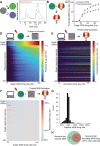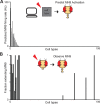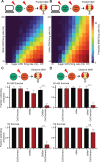This is a preprint.
A leaky integrate-and-fire computational model based on the connectome of the entire adult Drosophila brain reveals insights into sensorimotor processing
- PMID: 37205514
- PMCID: PMC10187186
- DOI: 10.1101/2023.05.02.539144
A leaky integrate-and-fire computational model based on the connectome of the entire adult Drosophila brain reveals insights into sensorimotor processing
Update in
-
A Drosophila computational brain model reveals sensorimotor processing.Nature. 2024 Oct;634(8032):210-219. doi: 10.1038/s41586-024-07763-9. Epub 2024 Oct 2. Nature. 2024. PMID: 39358519 Free PMC article.
Abstract
The forthcoming assembly of the adult Drosophila melanogaster central brain connectome, containing over 125,000 neurons and 50 million synaptic connections, provides a template for examining sensory processing throughout the brain. Here, we create a leaky integrate-and-fire computational model of the entire Drosophila brain, based on neural connectivity and neurotransmitter identity, to study circuit properties of feeding and grooming behaviors. We show that activation of sugar-sensing or water-sensing gustatory neurons in the computational model accurately predicts neurons that respond to tastes and are required for feeding initiation. Computational activation of neurons in the feeding region of the Drosophila brain predicts those that elicit motor neuron firing, a testable hypothesis that we validate by optogenetic activation and behavioral studies. Moreover, computational activation of different classes of gustatory neurons makes accurate predictions of how multiple taste modalities interact, providing circuit-level insight into aversive and appetitive taste processing. Our computational model predicts that the sugar and water pathways form a partially shared appetitive feeding initiation pathway, which our calcium imaging and behavioral experiments confirm. Additionally, we applied this model to mechanosensory circuits and found that computational activation of mechanosensory neurons predicts activation of a small set of neurons comprising the antennal grooming circuit that do not overlap with gustatory circuits, and accurately describes the circuit response upon activation of different mechanosensory subtypes. Our results demonstrate that modeling brain circuits purely from connectivity and predicted neurotransmitter identity generates experimentally testable hypotheses and can accurately describe complete sensorimotor transformations.
Figures





References
-
- Bates AS, Schlegel P, Roberts RJV, Drummond N, Tamimi IFM, Turnbull R, Zhao X, Marin EC, Popovici PD, Dhawan S, Jamasb A, Javier A, Serratosa Capdevila L, Li F, Rubin GM, Waddell S, Bock DD, Costa M, Jefferis GSXE. 2020. Complete Connectomic Reconstruction of Olfactory Projection Neurons in the Fly Brain. Current Biology 30:3183–3199.e6. doi:10.1016/j.cub.2020.06.042 - DOI - PMC - PubMed
-
- Buhmann J, Sheridan A, Malin-Mayor C, Schlegel P, Gerhard S, Kazimiers T, Krause R, Nguyen TM, Heinrich L, Lee W- CA, Wilson R, Saalfeld S, Jefferis GSXE, Bock DD, r SC, Cook M, Funke J. 2021. Automatic detection of synaptic partners in a whole-brain Drosophila electron microscopy data set. Nat Methods 18:771–774. doi:10.1038/s41592-021-01183-7 - DOI - PMC - PubMed
Publication types
Grants and funding
- MC_U105188491/MRC_/Medical Research Council/United Kingdom
- F32 DK117671/DK/NIDDK NIH HHS/United States
- R35 NS111580/NS/NINDS NIH HHS/United States
- RF1 NS121911/NS/NINDS NIH HHS/United States
- WT_/Wellcome Trust/United Kingdom
- F32 DC018225/DC/NIDCD NIH HHS/United States
- U24 NS126935/NS/NINDS NIH HHS/United States
- RF1 MH129268/MH/NIMH NIH HHS/United States
- RF1 MH120679/MH/NIMH NIH HHS/United States
- RF1 MH117815/MH/NIMH NIH HHS/United States
- R01 NS121911/NS/NINDS NIH HHS/United States
- R01 DC013280/DC/NIDCD NIH HHS/United States
LinkOut - more resources
Full Text Sources
